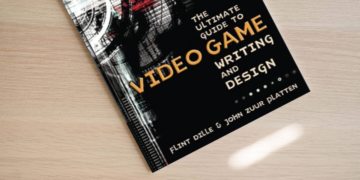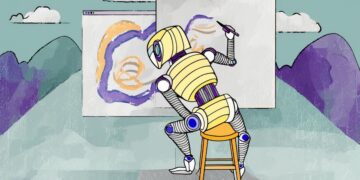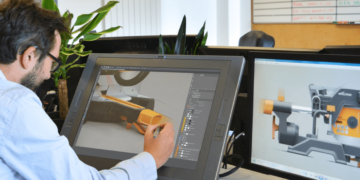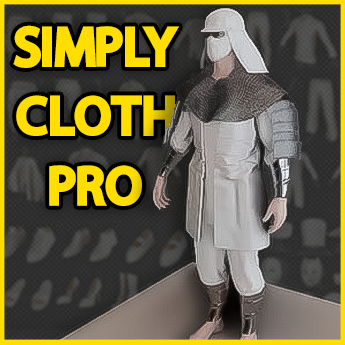If you are interested in the computer graphics industry, whether you are a 3d artist, an architect, or a graphic designer. You probably wondered about how exactly humanity switched from paper to digital. And how 3D computer programs were developed for the first time.
In this video, we are going to go over a brief history of Sketchpad the First 3D Software in History, and the person who worked on it in the early days when graphics software was not even a thing.
Sketchpad the First 3D Software in History
The history of 3D modeling started with mathematical ideas that are behind 3D visualization.
Basic ideas came from the founders of mathematics sciences, like Euclid who invented geometry, Descartes who developed analytic geometry, and James Joseph Sylvester who invented Matrix mathematics, which is now at work for every computer-generated image.

The biggest breakthrough came from Ivan Sutherland who introduced Sketchpad the First 3D Software in History, also known as “Robot Draftsman,” in 1963, with its revolutionary interface. Sketchpad established the fact that designers and potentially Artists could use computers, not only for engineering or for repetitive drafting, but also interactively.
Sketchpad pioneered some of the most important concepts in computing, including the graphical user interface, non-procedural programming, and object-oriented programming. If you use a computer or smartphone, you are using technology pioneered by Sketchpad. It also led to the advanced development of other imaging software, such as computer-aided design programs used by engineers and architects.
With Sketchpad, Ivan was a pioneer of human-computer interaction that made computers intuitively easy for humans to use, because of that, Ivan is considered by many to be the creator of Computer Graphics.
Sketchpad was an innovative system developed by Ivan as part of his Ph.D. thesis. Sketchpad the First 3D Software in History, actually defined the Graphical User Interface more than 20 years before the term was first used.
Sketchpad is considered as the ancestor of modern computer-aided design and Animation programs, as well as, a major breakthrough in the development of computer graphics in general. It uses drawing as a novel communication medium for a computer. The system contains input, output, and computation programs, which enables it to interpret information drawn directly on a computer display.

For example, the graphical user interface (GUI) was derived from Sketchpad, as well as, modern object-oriented programming. Ivan demonstrated with it that computer graphics could be used for both artistic and technical purposes, in addition to showing a novel method of human-computer interaction.
The Father of Computer Graphics

Ivan was born in Nebraska on May 16, 1938. His father had a Ph.D. in Civil Engineering, as well as his mother. A teacher, led Ivan to appreciate learning. He was immersed in learning since he was young. His favorite subject in high school was geometry, and he always described himself as a visual thinker, because of his interest in computer graphics.
Ivan’s first computer experience was with the famous computer Simon of Edmund Berkeley. And his first big computer program was to make Simon divide.
Sutherland went on the study at Carnegie Mellon University; where he earned a Bachelor’s degree in Electrical Engineering and then went on to earn an M.S. also in Electrical Engineering, from the California Institute of Technology. For his Ph.D., Sutherland went to MIT (Massachusetts Institute of Technology) where he studied under great professors.
The atmosphere of academic freedom at MIT allowed some students to start to think of more exciting lines of research.
Sutherland was impressed and he decided that the TX-2 should be a good machine with which to implement a real-time drawing program.
It is where he developed his revolutionary thesis. His’s Ph.D. thesis was titled “Sketchpad: A Man-Machine Graphical Communication System”, the first Graphical User Interface.

In 1963 Ivan found himself drafted into the army and assigned to the National Security Agency – because he knew about computers.
He realized that the government’s involvement in computers was huge. The NSA measured its computing power in “acres”.
In 1964, he was transferred to the Advanced Research Projects Agency, ARPA, and he was responsible for many of the computing projects, including the Internet. At the age of 26, First Lieutenant Ivan E. Sutherland was given control of $15 million dollars a year, and was told to “go sponsor computer research”.
Over the following two years, he commissioned and managed a range of computer projects that included AI and timesharing. He also met Dave Evans, then at the University of California at Berkely working on timesharing. It turned out that Evan’s understanding of real-time computing held the key to implementing practical computer graphics.
As a result of his work on Sketchpad the First 3D Software in History, and his many subsequent contributions to computing, Sutherland has received a dazzling array of honors. He received the Turing Award from the Association for Computing Machinery in 1988 for the invention of Sketchpad. He is a member of the National Academy of Engineering, as well as the National Academy of Sciences among many other major awards.
In 1968, Ivan Sutherland and David Evans founded the first 3D graphics company, “Evans & Sutherland”. They started the company to produce hardware to run the systems that were being developed but were soon also developing software. Their appearance and success in the market inspired others to start up their own companies and work on developing the technology.
A closer look at Sketchpad

Sketchpad the First 3D Software in History ran on MIT Lincoln Labs’ TX-2 computer. It was, at the time, one of the biggest machines in the world, with 306 kilobytes of core memory. It differed from most contemporary computers, in that it was designed to test human-computer interaction.
Sketchpad was developed at MIT’s Lincoln Laboratory on a TX-2 computer. The computer was very advanced for its time and had 320kb main memory, an 8Mb magnetic tape storage device, a 7 inch 1024×1024 monitor, a light pen, and a button box. As with most computers of that era, programs were written in macro-assembler, punched onto paper tape, and fed into the computer’s paper tape reader. The computer occupied about 1,000 square feet (or 93 square meters) and the 320kb memory core alone was about 0.76 cubic meters.
Unlike earlier computer applications, which were batch-oriented, Sketchpad was interactive. A Sketchpad user sketches directly on a computer display with a “light pen.” The light pen is used both to position parts of the drawing on the display and to point to them to change them. Using the light pen and input buttons, you could draw directly on the screen, using a crosshair cursor. The program supported points, line segments, and arcs as basic elements, but allowed these to be saved into master drawings, which could be copied or instanced. A set of pushbuttons control the changes to be made such as “erase”, “move”, etc.
Sketchpad the First 3D Software in History was an incredible breakthrough because of the way that it allowed the user to interact with the computer:
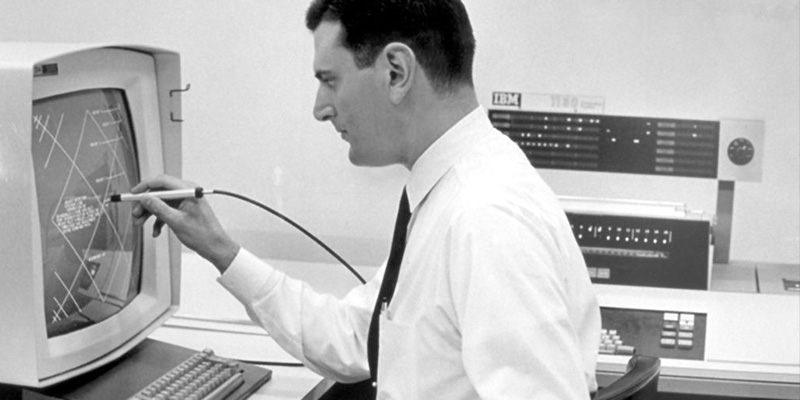
• The light pen was used to draw directly on the computer’s monitor and incorporated graphical user interface techniques such as rubber-banding of lines and zooming,
• Rubber-banded lines could be constrained to always intersect at a precise angle,
• An advanced memory architecture was developed that allowed the creation of master objects and “instances” which were very memory efficient copies of the masters,
• The master-instance concept allowed the creation of a master drawing and then duplicates to be created which would inherit properties of the objects in the master drawing unless they were locally changed,
• If the master drawing was changed then the changes would automatically be propagated through the instances in any duplicates.
Sketchpad the First 3D Software in History included 17 different types of constraints, including vertical, horizontal, perpendicular, coincident, parallel, aligned, equal size, and more. These native or “atomic” constraints could be combined, to create more complex relationships. Sketchpad even allowed the visual display of constraints on screen, using icons to represent each type.
With the constraint system, it was possible to loosely sketch a shape, and then add geometric and topological relationships to modify it into the exact shape you needed.

Visually, Sketchpad the First 3D Software in History was surprisingly interactive. It supported rubber banding when drawing or editing entities, so the entities would stretch as you move the cursor. It supported the dynamic move, rotate, and scale of entities, meaning that they moved, rotated and scaled as you move the cursor. It not only supported zoom and pan but did so transparently.
Due to all the characteristics of Sketchpad, it proved beyond doubt that computers could automate repetitive design and drafting tasks with reliability and accuracy not possible by manual methods. Sketchpad proved that computers can be used not just for engineering and repetitive drafting but can be used interactively by designers and potentially artists in the concept creation and innovation stage of a product’s lifecycle.
Further development after Sketchpad
Ed Catmull created a curved, realistic model of his wrist, which brought a dose of realism into visualization. He also developed Z Buffering – texture-mapping algorithms, crucial for the display of bi-cubic surfaces and shapes.
Martin Newell created a teapot, creating a simple three-dimensional form.
Jim Blinn was the first person who applied texture mapping and bumps mapping into a 3D model by using the algorithms of texture mapping developed by Catmull. Then he added reflection and scanline algorithm for bi-cubic patches. After multiple improvements, Blinn started to create 3D animations.

In The 1970s, companies began to offer automated design and drafting systems.
In 1971, a CAD system called ADAM was released. ADAM was designed to work on as many machines as possible.
MAGI Company introduced solid 3D modeling, were creating new demand for CAD,
Gouraud and Phong discovered techniques for shading at the University of Utah, which sped up processing by simplifying the original algorithms for rendering, and delivered better visual results in light, reflection and shading.
An item of interest was the Utah teapot model. It appeared in history as the symbol for 3D computer graphics after it was used by Martin Newell to test his graphical research.
In 1983, the 2D system AutoCAD was released. It was the first significant CAD program in the history of 3D modeling for the IBM PC, But they were not dominating the market for long because commercial CAD systems were showing up in aerospace, automotive, and other industries throughout the rest of the decade.

The 1990s
At this point in the history of 3D modeling, CAD software was widespread and being tested to its limits. After that, we had 3D printing until nowadays.
Today
Computer graphics is a core technology in digital photography, film, video games, cellphone and computer displays, and many specialized applications. Whether you are an architect or a web designer, a fashion student or a scientist, computer graphics can make your work quicker, easier, and much more effective.






